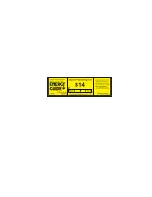
Setting Up
4-8
9161-A2-GH30-20
September 1997
Table 4-1.
Network Interface Options (2 of 7)
Line Coding Format
Possible Settings: AMI, B8ZS
Default Setting: B8ZS
Specifies the line coding format for the network interface.
AMI – Uses Alternate Mark Inversion (AMI) line coding format.
B8ZS – Uses Bipolar 8 Zero Suppression (B8ZS) line coding format.
Line Build Out (LBO)
Possible Settings: 0.0, –7.5, –15, –22.5
Default Setting: 0.0
Specifies the line build out for the signal transmitted to the network.
0.0, –7.5, –15, –22.5 – Specifies line build out in dB.
Bit Stuffing
Possible Settings: 62411, Part68, Disable
Default Setting: 62411
Determines the type of bit insertion to provide ones density requirements for data
transmitted to the network.
Bit Stuffing does not appear if Line Coding Format is set to B8ZS.
62411 – Inserts a one in the data after 15 consecutive zeros are received or the density
of ones falls below 12.5%. This setting complies with AT&T TR 62411.
Part68 – Inserts a one in the data if 80 consecutive zeros are received or the density of
ones falls below 12.5%.
Disable – Does not enforce ones density on the data sent to the network.
Network Initiated LLB
Possible Settings: Enable, Disable
Default Setting: Enable
Allows the initiation and termination of the line loopback (LLB) to be controlled by the
receipt of LLB-Actuate and LLB-Release commands from the network.
Enable – LLB is controlled by LLB-Actuate and LLB-Release commands. Receiving a
LLB-Actuate command causes the NAM to enter a line loopback (provided an LLB can
be performed in the T1 access unit’s current state). Receiving a LLB-Release command
terminates the LLB.
Disable – The T1 access unit ignores the LLB-Actuate and LLB-Release commands.
NOTE:
When disabled, the NAM is not in compliance with ANSIT1.403 or
AT&T TR 62411.
















































